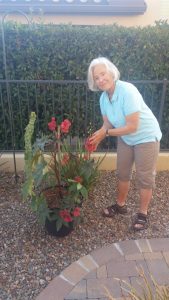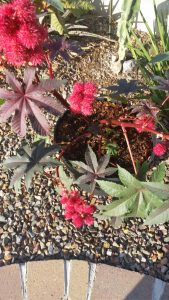Whether you're a seasoned gardener or still just testing the waters (or soils, as it were), you've probably discovered that gardeners & their approach to cultivation are as wonderfully diverse as the plants they tend and indeed, the folks themselves. What freedom and adventure our little patches of earth can offer us! But don't take our word for it, each month we'll be asking local garden folks 12 questions about their gardening (mis)adventures. This month, Zann Wilson, a Pinal County Master Gardener, will share some her garden wisdom with us. Happy planting!
1.) When did you first discover your green thumb?
I first became seriously interested in gardening about 45 years ago, soon after I was married. My husband and I had a small condo in a Chicago suburb, with very little space to garden. We planted bulbs and layered that area with other perennials, which grew and bloomed after the bulb display had dwindled. We grew a few tomatoes and thought we had the best garden ever!
2.) What is your favorite time of year (season) to garden?
The best time of the growing year, no matter where one lives, has to be spring. Even in our desert year-round gardening climate, spring still exudes that “fresh start” inspiration. The air is cool, but warming; the plants are waking from semi or complete dormancy and the ground is ready for seeds. I am especially fond of the burst of spring wildflowers in my yard, on trails and in the mountains. Even along highly traveled highways, the wildflowers strut their stuff in the spring.
3.) Biggest gardening success? Flop?
My best gardening success/flop has to be last year’s tomato crop. They grew in the cooler months, but as June arrived, the plants waned, required more water, and still looking peaked. After reading all I could about the solution to the problem of intense summer heat and sunshine on tomatoes, I decided that putting tall plants in front of the tomatoes to shade them was the only solution. I had recently visited Avocado Nursery in Casa Grande, owned by Phil Bond, the first Master Gardener in Pinal County AZ, opens a new window. He offered me some castor bean seeds.
Ahha! I was familiar with castor beans, so I figured that this was the answer to shading the tomatoes. In Indiana, my prior location, I had grown them and loved the huge leaves they sported. I figured this had to work here as shelter from the sun. So, in my 15’ X 6’ raised garden bed, last May I planted ONE castor bean plant which I had started in a pot from Phil’s seed. The transplant grew well. With good water and lots of sunshine, it grew and grew and grew. I had all the shade I could ask for since the castor bean leaves were about 18” in diameter. It looked more like a tree than an annual plant. I joked with friends who visited my garden that I now understood the tale of Jack and The Bean Stalk. This was the beanstalk reaching to the sky!
Yes, the tomatoes grew well. In fact, I finally yanked them out in November, though they were still producing. I was just tired of them and ready for a fall crop in my limited space. The real story, though, is the castor bean. I figured that it would eventually get hit with cold weather and die. So wrong. By November, my husband and I had to use an axe to cut the 12” trunk from the ground. I am still pulling up monstrous roots as large as 1” in diameter from my vegetable bed.
FYI, this year, I am growing a special red flowering castor bean in a container. I intend to keep this one under control.
4.) Do you grow from seed or starts?
I grow my vegetables from starts, but my ornamental garden is a mixture of purchased plants and those I have propagated. I enjoy playing with stem and leaf cuttings of cacti and succulents. There’s nothing more satisfying to me than to have a cactus grow and flower from a cutting. I’m also expanding my wildflower collection from seed that I gather on hikes and receive as gifts from friends.
5.) Favorite recipe for your harvest?
My favorite harvest recipe would be simple dish of freshly picked tomatoes, basil from the garden, and a splash of balsamic vinegar with olive oil. Nothing better on a hot summer evening.
6.) What special challenges do you face gardening in the desert?
Gardening in the desert is like no other gardening. As a lifelong mid-westerner, I am accustomed to the occasional wet year, the seldom seen drought, hail, fungal problems cause by high humidity and insects of all sorts…however, upon coming to the Sonoran Desert, I have learned that gardening might be easier on Mars!
Probably the greatest challenge to me is the balance of irrigation that’s not too much, not too little, but just right.
Depending upon the type of plant in question - cactus, other succulent, vegetable, annual flower, trees, shrubs - the soils and the exposure make each situation a unique problem so far as irrigation is concerned. I often tell gardeners that there are no rules to desert gardening. You’ll seldom find a situation where one answer always brings consistent results. So experimentation, often to the detriment of the plant, is the only way to learn.
7.) What are you growing now? And what are you getting ready to plant?
Currently, I am playing with some propagation types in preparation for a talk at the library. I have several herbs in water, rooting, and many succulents in various stages of growth. Succulents and cacti propagate so readily from leaf and/or stem cuttings - it’s a miracle of nature that we can so easily make more of our favorite plants.
8.) Planting dates, do you follow religiously or do you tempt fate and experiment with when to plant?
As for planting dates, I have found that on an average temperate year, the dates for planting edibles as well as ornamental plants can vary. If the intense sunshine of summer is mitigated in some way with shade cloth or other natural shading, and the colder temps of winter are compensated for by moving or covering plants, the growing seasons are relatively flexible. The real secret to pushing the seasons is knowledge and experience, AND a willingness to fail. I don’t know who said it first, but I was told this came from the southern public garden designer J.C. Raulston: “If you haven’t killed a plant three times, you’re not trying hard enough.” I take this to mean that location, soils, irrigation and other considerations must be a subject of trial and error. When the third variation is not successful, then it’s time to quit.
9.) Most indispensable garden tool?
I leave a sturdy trowel stuck into the soil in three different locations in my garden. Then, wherever the need arises, the trowel is at hand. Additionally, an arsenal of long handled tools is essential for ornamental gardening. I have long tongs and a tweezer tool that is over 12” long. I use these to grasp prickly plants and maneuver them. A bit of creativity is always essential for manipulating plants you wish to transplant. Keeping cacti and succulents in the same orientation to the sun as they were originally grown is important. Unfortunately, in the process of wrangling these uncooperative prickly plants, injury to them or to the gardener can occur if the right tool is not used.
10.) What’s your favorite gardening book?
I consider myself a student of plants and how they work. Currently I am reading The Hidden Life of Trees by Peter Wohlleben. The mysteries of the plant world are an especially interesting topic to me. Linda Chalker-Scott’s The Informed Gardener or local authors such as Scott Calhoun (The Gardener's Guide to Cactus) and Greg Starr (Agaves) are invaluable resources for desert gardening.
11.) If you were a plant, what plant would you be and why?
If I were a plant, I would definitely be a tree – probably a Douglas fir. I’m a sociable person and so are trees, as we are learning. The mother tree of Avatar fame was a notion that James Cameron probably got from reading Mycelium Running by Paul Stamets. Science is revealing that trees form underground connections through the medium of fungal networks. These networks support resource sharing as symbiotic partners with the tree community. I want to live in that supportive world – giving and taking as the need arises.
12.) Are you a seed saver?
Seed saving is a hallmark of my gardening. I don’t do a lot with vegetables because of lack of appropriate space, but I save many varieties of ornamental seeds – especially wildflower seeds. The desert is the queen of seed spreading- from the iconic Saguaro to the modest roadside spring flowering lupine. Growing these and many other desert natives from seed is easy and satisfying.
Is there a local gardener that you'd like to see featured as one of our monthly guests, or perhaps you'd like to be an upcoming guest contributor? Please email us at Seed.Library@pima.gov with your suggestions.




